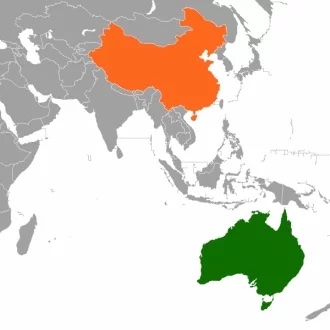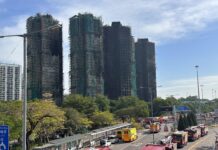The Australian ruling class have no solution to the problem they face. If they cut out China, they face the loss of their most important trading partner. If they engage with China, they weaken the imperialist goals of the US, and strengthen those of China.
David Elliott, Socialist Action (ISA in Australia)
The Australian government has stepped up restrictions on Chinese investment over the last year. Chinese investment in Australia dropped 61% in 2020, to around $1 billion. At its peak in 2016, investment from China stood at $16.5 billion.
The Morrison government has moved to discourage Chinese investment on ‘national security’ grounds. This is despite the fact that they need foreign investment and trade to shore up the economy.
The drop in investment is being driven by the conflict between the US and China. China’s global influence has grown, posing a threat to US dominance. At the same time its commercial relationships with Australia have also grown.
Capitalist governments globally are fearful of rising social discontent, and are moving to protect their own ruling class against the capitalists of neighbouring countries. As Australia and China’s ruling classes come into conflict, racism is being whipped up against Chinese people. This breaks down unity between working class people and needs to be fought back at every turn.
Conflicts between the capitalists of different countries have a huge impact on ordinary people, but neither the Chinese, US, or Australian ruling classes have any of our interests at heart. Their conflict leads to economic uncertainty, threatening job losses and widespread hardship. In the worst case, it may lead to war.
US vs China — a New ‘Cold War’
As China has risen in influence, the influence of the US has been weakening. This has led to an inevitable conflict between the two powers. This is an imperialist conflict — both want to secure access to markets and resources for their own ruling class, and are willing to use economic and military threats to do it. While the US government claims to oppose the brutal repression in China, it happily supports dictatorships elsewhere — its problem is with China threatening US dominance.
The conflict sharpened under the Trump administration. We have seen the development of a US-China trade war, and an escalation of their geopolitical rivalry on issues such as Taiwan, the South China Sea, and China’s relations with India.
Australia plays the role of a minor imperialist power in the Asia-Pacific region. It is militarily aligned with the US. As well as the US facility at Pine Gap, a number of Australian airbases provide support for the US Air Force.
Australian warships patrol the South China Sea, where China has made sweeping territorial claims that put it at odds with governments such as Vietnam and the Philippines. Australia is also part of a number of military alliances designed to counter China, such as the Five Eyes surveillance network, and the Qaudrilateral Security Dialogue with the US, Japan and India.
A full-scale war between the US and China is unlikely, because of the threat posed by the existence of nuclear weapons. Capitalists also fear the social convulsions that such a war would provoke. But there is a strong possibility of more limited shooting wars. This has already happened between the Chinese and Indian armies over part of the border in the Himalayas.
So far, the conflict mostly takes the form of a fight over trade and technology. In 2018, the Australian government banned the Chinese firm Huawei from the rollout of the Australian 5G network. It also intervened to block Huawei from building an undersea cable between Australia and the Solomon Islands. This is part of a broader strategy driven by the US, with the US, Japan, UK, France and now potentially India also blacklisting Huawei from their markets.
The Australian government has also moved to counter China’s political influence in the Pacific region. The Australian government supports a number of South Pacific governments, seeking to maintain access for Western imperialism to political leverage, markets, and profitable natural resources. Recent moves by China to provide investment to these governments prompted a “Pacific step-up” in Australian aid.
Recently leaked documents in Papaua New Guinea show a plan by Chinese interests to a build a small city, ‘New Daru City’, on the island of Daru near the Australian sea border, and there is an ongoing dispute between the Australian and PNG governments over a China-backed fisheries proposal on Daru. The Business Council of Australia was alarmed by this dispute, and has urged the government to send more aid to the region to counter China.
China-Australia trade conflict
The tension with China goes back many years, with Australia making use of ‘anti-dumping’ measures to place tariffs on foreign goods, with a focus on China. The goal is to protect Australian capitalists from competition. They accuse China of ’dumping’ underpriced goods onto the world market, threatening to out-compete Australian goods.
As China’s economy has grown in influence, it has become the main target of anti-dumping measures. In 2016, Australia’s Productivity Commission reported that between 1995–2005, 11% of Australian anti-dumping measures were against China. From 2005–2015, this rose to 34%.
Since the 2008 global financial crisis, governments around the world, including Australia, have increased the use of protectionist measures to protect local industries. They use the language of free trade to justify this. ‘Countervailing measures’, extra tariffs placed on foreign goods to make up for them being subsidised by foreign governments, used to be rare but have become more common since 2009.
Under capitalism, capitalist countries are both trade partners and competitors. Free trade and globalisation is encouraged on one hand to open up new markets for capitalists, while at the same time these policies increase competition and drive capitalists to use protectionist measures like tariffs. Globalisation has driven job losses in Australian manufacturing. This creates pressure from some sectors to use protectionist measures, making trade conflicts sharper.
Australia’s dependence on China
The imperialist conflict between the US and China creates a special problem for the Australian ruling class. In the last two decades, China has grown to become Australia’s largest single trading partner for both imports and exports. The reason for this is the same as for the new Cold War itself — the emergence of China as a major imperialist power.
Australia avoided the worst effects of the 2008 Global Financial Crisis for two main reasons: government guarantees on bank deposits and iron ore sales to China.
In 2020, the pandemic was the trigger for the deepest recession since the 1930s. Growth then bounced back in what appears to be the fastest recovery since the 1970s. But none of the major factors that led into the crisis were resolved. The Australian economy is still plagued by low wages, insecure work, poor welfare support, inflation, and large amounts of household debt. Even after major public stimulus, working people cannot spend enough to hold off recession indefinitely, because the economy does not work for us to begin with.
While the pandemic was the immediate trigger for the 2020 recession, the underlying problems of capitalism still threaten a much deeper recession. This hasn’t happened yet, for reasons that are similar to 2008: unprecedented government spending to secure jobs, temporarily raise welfare, and prop up house prices, and unprecedented iron ore sales to China.
China needs Australian iron ore to produce steel for construction. 60% of its annual iron ore consumption is from Australia. The Chinese regime does have ways to replace Australian iron ore, but all of these are enormously costly.
An undeveloped iron ore deposit at Simandou in Guinea may be 5–10 years away from production. It has been called the “Pilbara killer”, a reference to the Pilbara in Western Australia, where most Australian iron ore is mined. Even so, Simandou is expected to produce 150 million tonnes of iron ore a year, compared to the more than 800 million tonnes of Australian iron ore bought by China last year.
The dependence cuts both ways — while Australia sold 800 million tonnes to China last year, the total seaborne market for everywhere else was 460 million tonnes, with some of that already supplied by Australia. Mining capitalists can’t replace China as a buyer. They depend on China continuing to produce massive amounts of steel.
This is not guaranteed, as Chinese spending has been fuelled by enormous amounts of debt. Most of the steel is used in China’s housing market, which is described by the Wall Street Journal as the “world’s biggest asset bubble”. Growth can’t continue indefinitely.
Division in the ruling class
There is a divide in the ruling class about how far to engage with China. This is playing out in a dispute between the Victorian and Federal governments. In 2018 the Andrews government in Victoria signed onto a deal under China’s Belt & Road Initiative (BRI), which allows Victorian firms to bid for contracts for BRI projects around the world. The deal encourages Chinese firms to invest in technology and agriculture and to bid for state government infrastructure projects.
The Victorian economy is very dependent on construction and real estate. But the overheated housing market has been threatening a downturn for many years, and this is still on the horizon. The Victorian government relies on revenue from taxes on property and land sales. In 2019 the Victorian government forecast a surplus; in November last year they reported a deficit for the last financial year of $6.5 billion, due to unprecedented spending in response to the pandemic.
China is already Victoria’s largest export market, due to agriculture and international students. These markets have been damaged by border closures and the trade war. Sections of the capitalist class are looking to China as a source of new foreign investment to support the economy.
This conflicts with the Federal government’s geopolitical concerns. Federal and Victorian governments have had a war of words throughout 2020 over Victoria’s BRI deal. In December, the government passed new laws allowing it to veto the deal, and gave the Victorian government a deadline of the 10th March to explain why the BRI deal is in the “national interest”.
Sharpening conflict in 2020
Total foreign investment in Australia dropped by 46% in 2020 according to UN figures, reflecting a global downturn in foreign investment connected to the pandemic. But the drop in Chinese investment was much greater. One source was reported in The Guardian as saying, “The feds are scaring off Chinese investment all over the place”.
Throughout 2020 the Australia-China relationship worsened, beginning with the Australian government joining US calls for an investigation into the original outbreak of Covid-19 in China. China then imposed long-threatened tariffs on Australian barley in May, and in November introduced unofficial customs bans on a number of Australian products, including sugar, coal, wool, barley and copper ore. Timber was banned on the basis of alleged pest infestations, and lobsters on the basis of hygiene standards.
The bans on Australian products are a way for the Chinese regime to send a signal to the US, and a warning to its allies not to join Biden’s proposed “coalition of democracies” to contain China.
In July last year, the Australian government added ‘national security’ restrictions to foreign investments, and gave the federal treasurer the power to cancel deals after they had been made. This power was used almost immediately, with Treasurer Josh Frydenburg cancelling the sale of Lion Dairy and Drinks, owned by a Japanese company, to China Mengniu Dairy.
In November, Australia signed the Regional Comprehensive Economic Partnership (RCEP), the world’s largest trade deal. The deal is designed to increase exploitation of both workers and the environment throughout South-East Asia. It’s expected that 90% of the income gains from RCEP will flow to China, Japan and South Korea. The deal represents an escalation of the conflict between China and the US, and a major diplomatic win for the Chinese regime.
Trade Minister Simon Birmingham claimed, “Economic cooperation of this scale sends a strong signal that our region is committed to the principles of open trade”, but the deal will not resolve the underlying causes for the long-standing trade conflict with China, or the intensifying imperialist conflict. There has been a free trade agreement in place with China since 2015, but this has not prevented the recent bans on Australian imports, which came immediately before the signing of RCEP.
Racism and imperialism
Throughout this growing conflict, Chinese-Australians have faced increasing amounts of racism. A recent Lowy Institute survey reported that 37% of Chinese-Australians reported being discriminated against for their race, with 18% reporting being physically threatened or attacked over the last year. The pandemic and diplomatic tensions were given as the main reasons for this.
It’s useful to capitalists to have people blaming Chinese people for their economic troubles. For example, when people place the blame on “Chinese investors” for inflated real estate prices, it shifts the blame away from the real problem — the capitalist housing market. The housing crisis exists because housing is treated as a commodity for profit, and the market is run in the interests of capitalist investors of all nationalities.
The Australian ruling class have no solution to the problem they face. If they cut out China, they face the loss of their most important trading partner. If they engage with China, they weaken the imperialist goals of the US, and strengthen those of China. Their concern is in carving out markets for themselves and protecting their own profits. Whichever way they lean, the clash between the US and China will go on, and risks driving the world towards further instability.
The scramble for economic and political dominance is the reason that powers like the US and China are trying to carve up the world into spheres of influence. Nationalistic, racist fearmongering is always brought out in these conflicts. This can easily get out of hand, fuelling the drive towards war.
We need to build international unity, on every side of every border, to resist racism and imperialism. Workers of every country have an interest in taking power into the hands of the working class as a whole. Capitalism is at the root of our problems.
For socialist internationalism!
We have more in common with Chinese workers than with Australian capitalists. Chinese and Australian capitalists both exploit working people, and this exploitation is the reason for the economic instability we face.
We need to take big business under the democratic control of working people, and run production for human need. Instead of being wasted on profits, the wealth we create should be under the control of the whole of society, and used to end poverty, hunger, homelessness, and fund efforts to fight pressing issues such as climate change.
With this collective effort we can organise trade between countries based on our collective needs — not based on a capitalist competition to divide up the world. Working people have an interest in co-operating globally, across borders, instead of competing for the control of markets and territory. This is why Socialist Action in Australia organises as part of International Socialist Alternative. We stand by workers in both the US and China, and fight for an end to capitalism, dictatorship and war.




